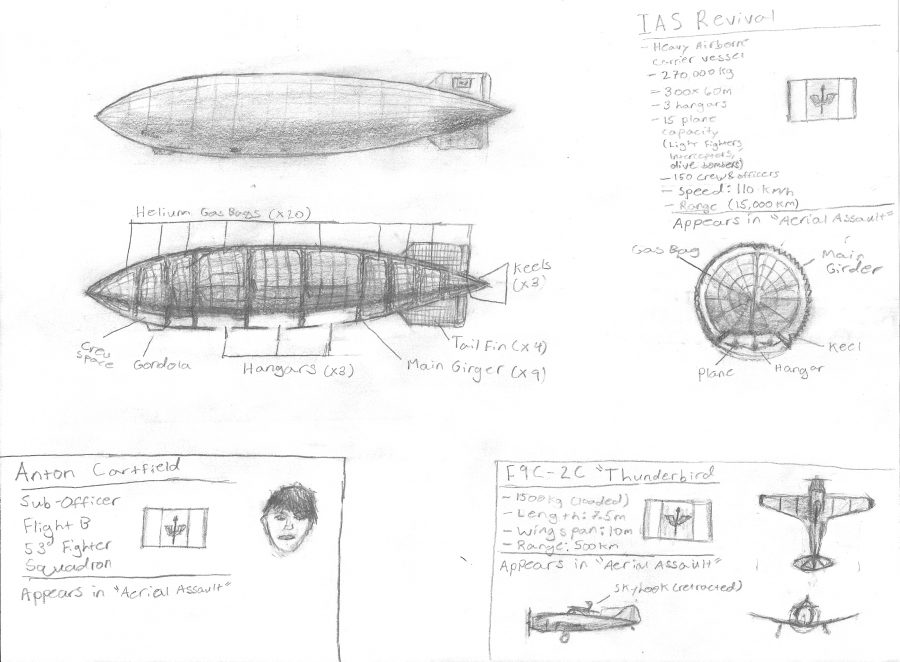By MILES HUNTLEY-FENNER
Student Contributor
Writer’s Note – This short story takes place in a fictional world with imagined continents, peoples, and cultures that are inspired by, but are not to be confused with those of Earth.
It had been twenty-four hours since the fleet of air-based aircraft carriers left their hangars in the Pölish Isles for the Strait of Lenoa. After years of planning and preparation, Pöland had secretly assembled its largest military force in over a dozen years, and was preparing to strike by land, sea, and air. The target of this invasive force, the nation of Rubidia, had long suspected the impending invasion, and thus had directed the bulk of its naval fleet along the western entrance of the Strait of Lenoa and the Northwestern edge of the mainland, the most logical landing site of a Pölish invasion. In response, the Pölish naval invasion fleet had painstakingly circumnavigated the entire continent of Lenoa under radio silence, hiding behind a storm front to conceal its position. After quickly resupplying in the Wüstland, the Pölish forces were prepared to strike near the eastern end of the strait, nearly 1,500 kilometers behind the bulk of the enemy fortifications. The significantly more versatile air-based carrier fleet had simply flown overland and rendezvoused with the rest of the invasion force at the strait in preparation for the impending assault.
The vast Lenoan nation of Rubidia, if conquered, would provide a wealth of coal, minerals, oil, and rubber. Rubidia, however, was extremely well fortified. With its immense population, it would require a massive military investment to conquer and maintain. Furthermore, although it had recently gained independence from the wealthy Western Nation of Ilbonia, Rubidia remained within the vice of economic imperialism. Ilbonia, which opposed Pölish remilitarization, would defend its Rubidian assets with its extensive resources. Hoping to avoid outright war, Ilbonia had established a covert flow of military hardware and resources to Rubidia. Pöland had known of this exchange for quite some time, but could do nothing to challenge Ilbonia without risking a second catastrophic war in less than twenty years.
Upon arriving within 200 kilometers of the coastline, the carrier fleet turned downwind, and prepared to launch its complement of fighters. Aboard the Airship Revival, there was a flurry of activity as orders were broadcasted over the intercom, and the 53rd Fighter Squadron prepared for takeoff.
Flight B of the squadron assembled in the lower left keel (this airship had three) outside of the second hangar. The pilots: Hubert, Anton, Leon, and Peter then filed into the hangar, wished each-other well, and boarded their respective F9C Thunderbird fighters.
The planes, which were situated in the four corners of the hangar, were each attached to a trolley by a “skyhook.” To launch, the trolley would move along a monorail system to the center of the hangar, and its plane would be transferred by its skyhook to a long trapeze. The crew would then lower the trapeze through a rectangular opening at the base of the hangar, at which point the pilot would activate his engine and disengage the skyhook, which he would fold behind the cockpit during unassisted flight. The pilots of Flight B all launched in this manner, and joined the rest of their squadron, which had launched from the other two of the Revival’s three hangars.
The attack strategy relied on strategic aerial bombardment of key military and civilian targets within immediate striking distance of the 30 kilometer beachhead on which the ground troops were to land. Command hoped that the resulting destruction of nearby military bases would prevent organized retaliation, and that the civilian chaos would disrupt army supply lines, giving the landing force ample time to capture the surrounding area with relative ease. The 53rd Squadron was to accompany three wings of dive-bombers in the first wave of an attack against Amana-ui Air Base, whose destruction would give Pöland regional air supremacy.
As the attack group approached the shoreline, Hubert unbuttoned the right breast pocket of his green flight suit with nervous hands, and removed a copy of “The Dichotomy”, a famous Salvationist (Salvationism is a popular Pölish religion) painting depicting the Island of Heaven in the Sea of Hell, captioned “Omnes Salventur,” or “All are Saved.” He gazed at the caption, consoling his fear in the prospect of universal salvation. Anton, an atheist, had no such religious momento, and was not afraid, but excited for his first combat mission. His eyes turned to the photograph of his deceased father, a former pilot, taped to his instrument panel in an ultra-thin aluminum frame. He thought of how proud his father would have been had he lived to see his own son follow in his footsteps. Leon, the most skilled pilot of his squadron, was not concerned with his mortality, predecessors, or even consciously steering his plane. Instead, he was busy drawing the sunrise in a pocket sized sketchbook that his sister had gotten before he left for assignment, many months ago. Peter, like Hubert, was quite nervous, and channeled his stress into scrutinizing his instruments and ensuring that every aspect of his plane was in working order.
The pilots progressed under radio silence, preventing the enemy from detecting their position, until Peter spotted the Air Base on the horizon and anxiously announced the sighting over the Group frequency.
Seconds later, the planes were suddenly met with an unexpected barrage of heavy anti-aircraft fire. Aircraft Spotters near the coast had detected the incoming planes, and notified the base ahead of their arrival, buying the Rubidian Air Force several precious minutes of preparation and eliminating the element of surprise. The pilots took evasive action, and scattered to attack their primary targets. Hubert, Leon, a handful of fighters, and a dozen dive-bombers equipped with armor piercing bombs broke off from the Group and headed for Black Rock Fuel Bunker, a series of subterranean fuel tanks that supplied the entire base with aviation fuel. While en-route, an anti-aircraft shell tore through the base of Leon’s left wing, rupturing his left fuel tank and damaging the oil radiator. Upon seeing his oil pressure and temperature gauges rise and his fuel gauge fall, Leon immediately closed the fuel cock for his ruptured tank, throttled back, and notified the rest of the Group of his craft’s condition. Instead of fleeing the battle, he remained with his fellow pilots to avoid being singled out and began to pick off the anti-aircraft gunners. Upon reaching the Fuel Bunker, the dive-bombers began their attack run, guided only by their memory of reconnaissance photos and diagrams of the underground Bunker’s location, as it was invisible to the pilots from the air. The first bomber missed, but the second hit its mark with deadly accuracy, resulting in a massive explosion as the aviation fuel ignited, destroying the bunker and engulfing the nearby Nguvu Lee Airfield in flames.
Elsewhere, dive-bombers were attacking the other four airfields, as Peter, Anton, and the other pilots were destroying imported Ilbonian fighters before their Rubidian pilots could get them off the ground. With very little warning of the attack, the Rubidians had been able to taxi and fuel many of their fighters, but were unable to take off in time. The Thunderbirds’ incendiary bullets made short work of the grounded and exposed fighters, and they rapidly transformed the airstrips into flaming scrapyards. As Leon and Hubert proceeded to their secondary objectives, Hubert’s plane became the unfortunate victim of a barrage of anti-aircraft fire, which tore through its right wing and sent it into a tailspin. Unable to regain control, Hubert crashed his plane in the inferno that once was the Fuel Bunker and died on impact, sparing him an agonizing death by immolation in the raging fire that consumed his plane.
After dropping the last of its bombs and firing the remainder of its bullets, the Group left as swiftly as it had come; and not a moment too soon, as Leon’s plane was running dangerously low on fuel. Flight B’s return was a mixture of celebration at the success of its mission juxtaposed with mourning for Hubert. Leon used his time to sketch “The Dichotomy” from memory, and took the liberty of depicting Hubert’s plane spiraling towards the Island of Heaven through a beam of light. Anton etched a notch representing his first mission on the back of his father’s picture frame and briefly neglected his atheism as he wondered if Hubert would seek out his father in Heaven. Peter, no longer burdened with the stress of the mission, turned his thoughts to poetry and began to mentally compose a poem in his comrade Hubert’s honor.
Before long, the 53rd Squadron regained radio contact with the fleet, and pinpointed the Revival’s location. As the squadron came within visual range of the Airships, the pilots distinguished the Revival’s registration number from its counterparts, and one by one, the planes extended their skyhooks and docked with the trapezes of their respective hangers. Although it was an objectively difficult maneuver, docking came easily to the pilots, each of whom had practiced the operation countless times. Even with its complexity, docking with a trapeze was much smoother and easier than landing on the rolling, pitching deck of a sea-based carrier.
These airborne carriers, though perhaps more vulnerable than their oceangoing counterparts, were quite inexpensive and versatile, and were a useful military application for Pöland’s practically limitless supply of Helium. As the 53rd Squadron debriefed, the fleet launched a secondary wave of attack, and thousands of Pölish ground troops streamed through the landing zone unopposed. The stage was set for Pöland’s invasion of Rubidia.
Categories:
Aerial Assault
October 29, 2017
0
Tags:
Donate to Sword & Shield
$180
$1000
Contributed
Our Goal
Your donation will support the student journalists of University High School. Your contribution will allow us to purchase equipment and cover our annual website hosting costs.




